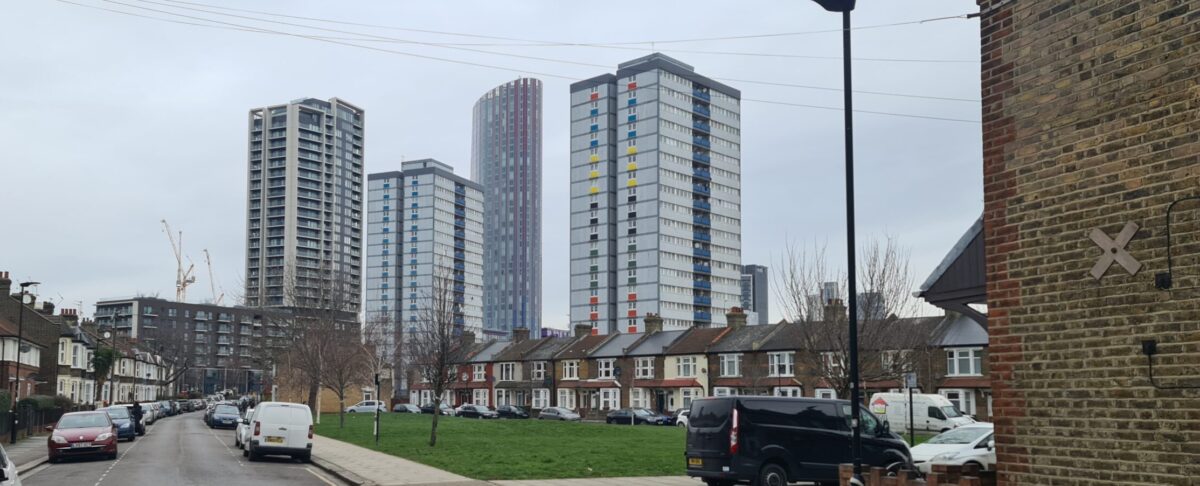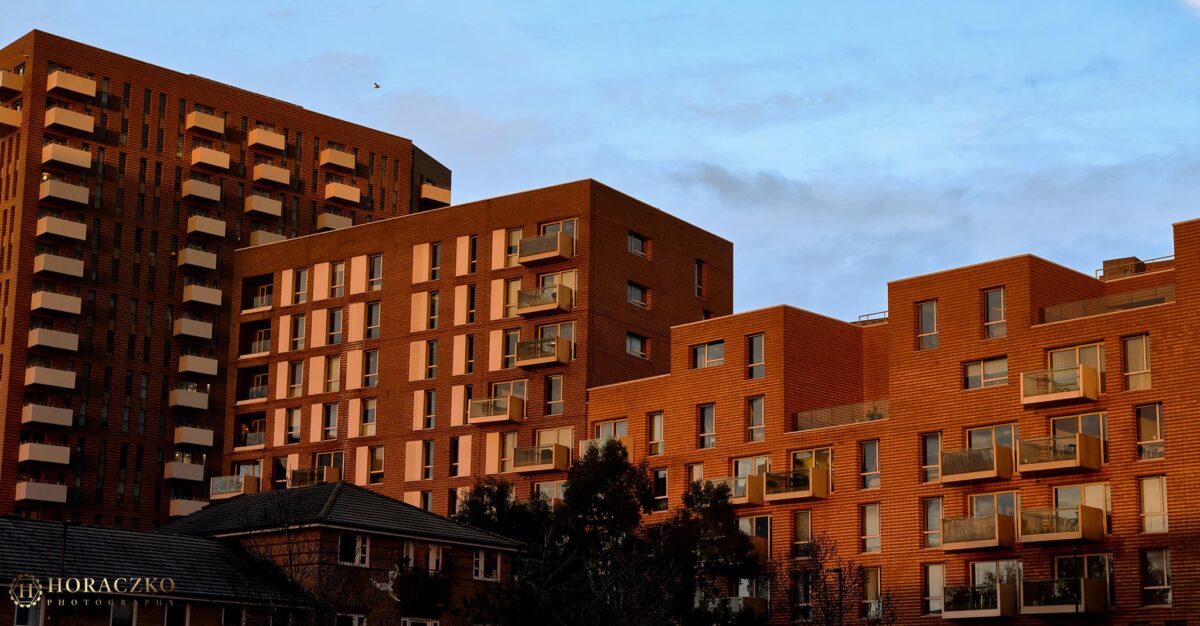In a way, it was almost inevitable that I would develop an interest in gentrification and housing. After all, I am a millennial and I grew up in Zone 2/3 of Inner London. I didn’t just watch my neighbourhood change as I grew up, I watched the door to a future my parents’ generation took for granted close before my eyes.
My parents moved to Forest Hill, South East London in the mid-80s. Even back then my parents couldn’t afford to live in Hackney or Tooting (my mum had been a big Citizen Smith fan). Growing up, South London was the butt of jokes – most of which revolved around it being poorly connected, scary or dull. But by the noughties, my area would start appearing in the aspirational columns about London’s new exciting suburbs. Housing prices rose sharply and continuously. The global housing market crash in 2008 couldn’t stop this runaway train and the last decade has seen my neighbourhood transform.
I noticed the most rapid changes taking place after 2011, when the London Overground was delivered to the area. I was away at university over this period and as I returned each summer, there were new cafes, estate agents and pizza places to replace the launderettes, sandwich shops and second-hand electronic stores. I remember chatting to the owner of Cafe No 41 on Brockley Rise around this period. He had owned Bertie Rooster’s Fried Chicken on the same site and he said he’d noticed the area changing, so he thought he’d better change too. Smart move.
Local NIMBYs, true to form, opposed the transformative rail connections. I remember my dad, who worked in transport, railing against the local opposition to it. He had been arguing for greater capacity for the Overground, for longer trains, and an additional station between Surrey Quays and Queen’s Road Peckham. As the Overground now sits at bursting point — a victim of its own success — he should’ve been listened to. Ironically, the Overgound has been a huge boon to their property-owning NIMBYs that opposed it.
But while I infamously remain sniffy towards NIMBYism, I do understand it. A rapidly changing neighbourhood can be discombobulating and disconcerting. As a strange teenager, I remember pleading with my friends to go to the array of cornershops in Honor Oak instead of the new Sainsbury’s Local if they were buying drinks and snacks before we had a kickabout in the park. Instinctively, I didn’t like what I saw as the homogenisation of my local mini-high street and I knew that Sainsbury’s would destroy some of those independent shops (it did) that I felt I had a relationship with. My instincts were to, in a way, keep my neighbourhood ‘static’.
I’ve been on a journey to try and understand the phenomenon that shaped my home town when growing up and understand my own feelings around it. While at university, I wrote my dissertation on the changing Toxteth and Canning areas of Liverpool. I had grand ambitions to start a university society that would work with the local community to improve ‘Town & Gown’ relationships in the nearby area. Like most of my plans, they crumbled due to a bad attitude and lack of endeavour. The dream ended with me getting into a fight at a Residents’ Association’s ‘cheese & wine’ night and quite literally being thrown out.
However, looking back on the experience, it gave me a good understanding of how gentrification works and was a valuable insight into a world I would later inhabit. Gentrification is an organic process and one seen in major cities around the capitalist world. The cliched but illustrative example is as follows – artists move into an area due to cheap rents and large spaces. They create an artistic community and the area becomes ‘cool’. With it being cool, it then becomes desirable. The greater appetite for the housing then pushes up rents and prices and gradually the area’s demographics shift.
It was once thought that cities would act like a pebble falling into a pond, rippling outwards and decaying inside. Yet from the 1970s onwards the shift has been back into the centre. Some hippies and squatters now own multimillion pound property in areas of our West End. Savvy boomers profited.
The process of gentrification can be sped by developers who see the opportunities offered by a rent-gap to maximise profits. In this, developers are simply capitalising on a saturated housing market and building where demand is. Likewise, ‘gentrifying’ businesses are responding to their new clientele not moulding customers from thin-air and wishes. Cereal cafes and posh chicken shops are a symptom of gentrification, not a cause. Today, many of the anti-gentrification activists I come across are ‘first wave’ gentrifiers themselves, similar if not a bit older than my parents.
While it is an organic process, gentrification does cause profound issues. Sharp rises in the cost-of-living create havoc for low-income families and at its starkest, drives them from their neighbourhood. As I mentioned in my last blog, social homes with secure and affordable rent is a fire-wall against gentrification. But London is increasingly being hollowed out, swathes of North & West London in zone 1 & 2 have become binary and soulless places – the very well-heeled live alongside enclaves of council homes occupying parallel lives. I worry that the evaporation of London’s Little Italy, will eventually happen to our Little Bengal and our Little Portugal.
***
My blood still curdles at a previous generation of local politicians who seemed to actively encourage the gentrification of their neighbourhoods, as a means of improving their patch. Gentrification doesn’t solve poverty, it just kicks it down the road. But for some local politicians, that once seemed enough. Angered by what I saw, I vowed to campaign against it. It signalled my first forays into local politics.
In my last blog, I wrote about Lewisham’s Residents Charter and how we’ve come along way from this era. Like our predecessors, we know that mixed communities are positive for social cohesion and shared uplift. Likewise, we also know that many of our large post-war estates are in need of urgent renewal. However, as an administration led by a new wave of politicians, we’re committed to ensuring that any regeneration produces a net gain in social homes, expanding our gentrification fire-wall in the borough.
Yet I do not remain hopeful for the future. Writing this, I am struck by just how long I was part of the problem and what that says for the future. I was driven into local politics by the anger that while my neighbourhood was being torn up and built back up, none of these homes were for me.
Developers, greedily lining their own pockets, were building ‘luxury flats’. Councils were failing to stand up to them and accepting schemes with pitiful amounts of affordable housing.
It’s been through sitting planning committee as a councillor that I learnt that most of these flats weren’t ‘luxury’. The only thing luxury about them was the unaffordable price. The housing crisis has simply become so insane in London that any market-value home is deemed luxury and therefore out of reach of someone like me — a young person without assets, earning the average London wage.
This situation has bred a culture of cynicism among an entire generation. As we discuss rents at house parties and scoff in frustration at the mere idea of saving for a deposit, we’ve grown suspicious of new housing and growth. Moreover, the council-led schemes of the past have led to a sour taste in people’s mouths. While these schemes, directly reducing social housing, could be an example of top-down gentrification — it would be wrong to view gentrification as a whole, as planted from top-down from developers.
If writing to note to my younger self, I’d be rather pithy. ‘Dear Leo, sick of chain stores and the champagne et fromages under those new flats? Let many, many, more flats just like that be built, so rents and prices round here come down and the demographics that fed those independent shops and the sandwich shop you loved so much, can remain.’ As this article highlights, the forces that drive gentrification ‘do not come from the construction of specific apartment buildings or retail complexes, no matter how many granite countertops or artisanal coffee shops they might contain.’ Increasing supply will lower prices.
***
It is only now that I see how damaging the framing of gentrification as a top-down process, thrusted-upon benign communities by developers, has been.
As a councillor, I have been shocked by the glacial and bureaucratic process of approving new homes in the borough. Not only that, I’ve seen how small interest groups have leant on councillors to reject new homes on spurious grounds.
But this is only the tip of the iceberg. As this Centre for Cities report highlights, our planning system operates like the old Eastern Bloc, rationing supply through a permit system. ‘In both the former Eastern Bloc and the English housebuilding market, firms must apply to planners for a permit, or a planning permission, to get the inputs they need to do business.’
We currently have a system that cannot respond to demand. Developers need to go through the process of receiving planning permission which is slow, often costly and fundamentally uncertain (planners can downsize or councillors can strike down an application, years into the process). This means ‘the amount of land that they can develop tomorrow is fundamentally unknown.’
It is this risk, inherent in our system, that means developers hoard land that has planning permission (or is likely to receive planning permission). As Centre for Cities notes, ‘this ‘hamster-like’ behaviour is rational as it means they will always have land on which those assets can be operating, even if planning permissions temporarily dry up.’ The report also notes:
‘A site that has planning permission or is suspected to have a high chance of receiving planning permission can greatly increase this price, especially near cities and large towns with successful economies and expensive housing’. To illustrative this point, in 2010, agricultural land without planning permission around Cambridge was worth roughly £18,500 per hectare. Once it received planning permission for housing, the value per hectare increased to £2.9m.
Developers must cover these high land costs, and they cannot escape them by increasing production or efficiency as the planning system rations the supply of land they require. They therefore need to pass their land costs onto consumers and sell new houses at high prices.
Developers experience a disadvantage trying to acquire land which can be lawfully developed, they enjoy the advantage of a sellers’ market when selling new properties to consumers due to slow buildout rates. This means that predominantly only big powerful developers can get hold of land which will get large-scale planning permission, and once they have hold it, they can build a slow ‘absorption rate’ keeping house prices high due.
If developers could instead just buy land and develop it without applying for a planning permission, then “planning gain” and thereby the absorption rate would both disappear. The price of land would reflect local demand and, as firms would and could only buy what they immediately needed, they would be forced to build new housing as quickly as possible to outcompete rival firms that could now do the same.
It is our system which creates the circumstances for large developers to be able to buy the rationed land for development and build slowly as they face little competition.
But this isn’t a cry to rip-up the rule book. Local planning frameworks should remain in place and offer clear rules of what can be built and where. However, areas zoned for development should be greatly expanded. As the campaign group Priced Out argues:
‘For the areas that are zoned for development, there should be transparent rules about what cannot be built there — which could include what the developments are used for, and rules on look and feel — with everything that does not contravene these rules allowed. Alongside this we already have extensive national building regulations, rules on the sustainability of developments, and various other regulation which is already in place.’
Priced Out Manifesto | Rules-Based Planning
However, when reaching out to colleagues to express these views and concerns, I receive immediate and blanket push-back. Those I speak to see the bureaucracy of our planning system as a bulwark against lowering standards. They instinctively reject ideas about cutting red tape and increasing competition to raise standards. Developers are the bad guys that need to reined in by councillors, rather than firms rationally gaming a broken system that we uphold.
It has become fashionable across the political spectrum to deny that our housing crisis is linked to a lack of supply. Campaigners against new market-sale homes often point to the fact that the UK has 216,000 long-term vacant homes, which could occupy a sizeable chunk of our 280,000 homeless people, if only they were happy to be bussed to Cornwall or Cleethorpes.
However, rather than suggesting that we do not need to increase supply, our empty homes highlight our nation’s stark housing shortage. In the UK, only 0.9% of homes are long term vacant. In a healthy market, surpluses provide ‘a strategic reserve which they can use to respond to sudden changes in consumer demand.’
Compare our situation to Japan, a nation with an affordable housing market. In Japan, less than 5% of homes are socially rented (here it is around 17%). Across Japan, 5.6% of homes are long-term vacant, while Tokyo the figure is 2.5% – which is a higher share of empty home than in Burnley – other most affordable city in England and the one with the most vacant housing. Suppressing vacancy rates in the UK will only make the situation worse. Instead, we need to build enough to homes to create a healthy surplus.
As I have written previously, the housing crisis cannot be tackled by local authorities building themselves. This blog succinctly nails the issue: The UK’s housing affordability crisis is too little supply, which cannot respond to prices. However, getting Labour Party colleagues and angry young millennials alike to accept that we need developments of market-rate properties on a huge scale in areas of the country where our housing shortage is most acute — will be an uphill battle.
Steam-rolling through reforms won’t work. Instead, we need to start that process of chipping away – gradually building a coalition in support for house building. And maybe one day we can get more people to say yes-in-their-backyard to luxury flats.



